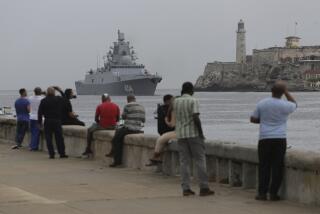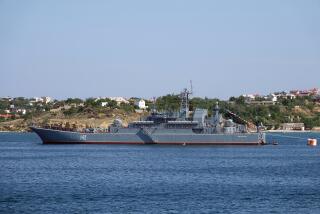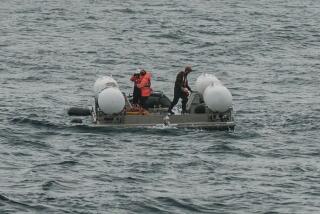Russians Call Sub Crash a Near-Disaster : Military: Naval officials say the U.S. vessel came within just yards of setting off a possible nuclear catastrophe. Americans reject the claim.
- Share via
MOSCOW — The U.S. nuclear submarine that collided with a Russian ballistic missile submarine in the Barents Sea two weeks ago came within just yards of unleashing a possible nuclear catastrophe, angry Russian navy officials alleged in remarks published Thursday.
In a note of Russian-American discord almost on the eve of Saturday’s summit in Vancouver, Canada, Rear Adm. Alexei Ovcharenko told the Rossiyskaya Gazeta newspaper that “mere luck saved the submarines from destruction.”
He accused the American submarine, the Grayling, of performing a “dangerous approach” even though it knew that the Russian submarine was nearby in the ice-covered sea. The Grayling hit the Russian submarine’s bow just 20 yards away from its conning tower, said Ovcharenko, who was just back from an inspection tour of the collision site.
If the Grayling had actually hit the conning tower, he said, the center of the submarine would have flooded immediately, it would have been impossible to cut off the sub’s two nuclear reactors, and “a thermonuclear explosion would have been inevitable.”
The collision endangered the Russian submarine’s 16 multi-warhead ballistic missiles as well, Ovcharenko told the newspaper. The Grayling risked piercing its own body on the Russian submarine’s rudders, he said, with the same possibly dire results.
In Washington, U.S. officials flatly denied that the March 20 collision could have unleashed a nuclear explosion.
“There’s no way that could have caused a nuclear explosion,” a U.S. Navy official said. “It’s physically impossible. That’s not the way nuclear explosions occur.”
Officials said the United States will not begin its formal investigation of the incident until the Grayling returns to its home port of Charleston, S.C., now expected around April 7. The vessel is returning to the United States under its own power.
At the time, the United States expressed regret over the collision, but officials said that was merely a polite gesture, not an admission that the Grayling was at fault.
Soviet and American submarines have long made a habit of playing “chicken” with each other on the world’s ocean floors during the Cold War years, but as relations warmed, their dangerous game was supposed to have been abandoned. Pentagon officials insisted when they confirmed the accident that no such maneuvers had been involved.
Both Russian and American naval officials acknowledged that damage was slight. But the incident triggered a show of open irritation from the Russian navy.
Rear Adm. Valery Alexin, also just back from the Barents Sea site, criticized the American submarine captain for leaving the scene of the crash.
“Like a boy caught stealing apples in the garden, the Grayling commander ran away from the place of the accident instead of offering to help the other victim of the accident, as is required by good naval practice,” Alexin said.
More to Read
Sign up for Essential California
The most important California stories and recommendations in your inbox every morning.
You may occasionally receive promotional content from the Los Angeles Times.










